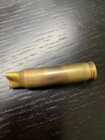If I get a chance I will try your suggestion.
Curiosity got the better of me. I grabbed a few old cases and ran them for extreme times. I did not notice any drop off in current, even running things to the point of a very brightly glowing case in a sunlit room. 14.2A for 15 seconds. (The case stuck in my shelf as it partly melted the trap door.) Now, these cheap ammeter/voltmeters we use may not be sensitive enough but there was plenty of time for it to react. The case in question is totally toast and I could just squeeze the neck flat with my fingers.











